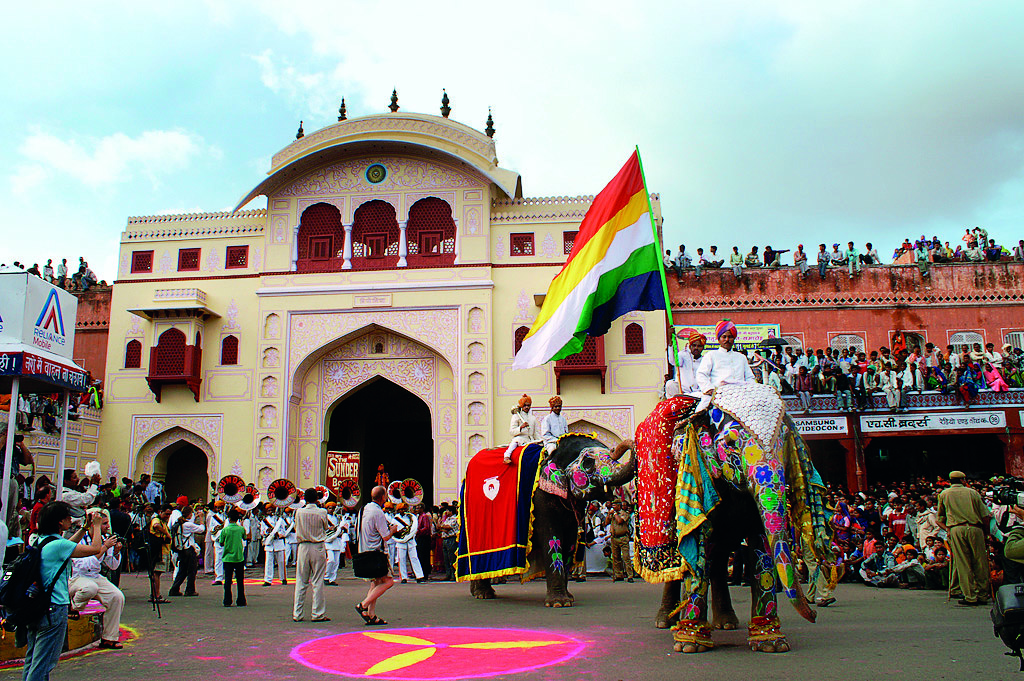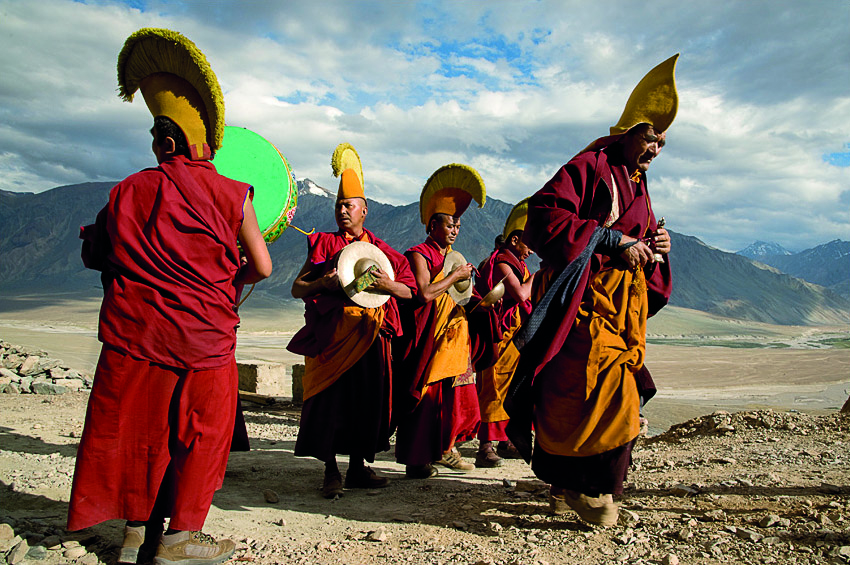TEEJ, JAIPUR
Jaipur may be the quintessential touristy city of India but few can beat its vivacity during the Teej festival when its splendor is at its colorful best.

Teej Celebration in Jaipur
Pink City swings to Teej
Celebrated all over Rajasthan, Teej is a delightful combination of faith and festivity and is essentially observed by women. While the day begins with married women praying to Goddess Parvati for the well-being of their husbands, the rest of the traditional two-day festival is spent in dressing up, singing, dancing and sharing specially-made sweets. One of the biggest attractions of this festival is the flower-bedecked swings. The merriment of the colourfully attired and bejewelled women of all ages has to be seen to be believed as they swing with abandon. In Jaipur, the preparations for the festival begin much earlier, with the women scouring the markets for colourful clothes — especially the lehariya (tie-and-dye) sarees — and ornaments.

Teej Celebration (Photo by GuilleDes)
On the day of Teej, a huge procession starts from the City Palace’s Tripoliya Gate in the late afternoon. Teams of musicians and dancers, processions of bedecked horses, elephants and bullocks precede the palanquin bearing the idol of Goddess Parvati, known as Teej Mata. The procession winds up at the Chaugan. To mark the festival, the state tourism usually organises a five-day cultural festival here that brings together not only various groups from Rajasthan but also from other states. Last year, a Food and Craft Bazaar was also organised for the occasion at Shilpagram. Since Teej is a monsoon festival and held during July- August, be prepared for the rains and a humid climate. With innumerable hotels, and this being outside the regular tourist season, finding accommodation is not a problem. But do remember, the Teej procession of Jaipur — an excellent photo op — is very popular and a humongous crowd gathers at the spot. So, you have to be really early to get a vantage spot. The main festival falls on July 22-23 this year.
Kajli teej
Located about 200 km from Jaipur, Bundi is one of the lesser-known towns of Rajasthan’s Hadoti region. A month after the rest of the state observes Teej, Bundi celebrates the Kajli Teej. Here too, the goddess is carried in a colourful palanquin and taken around in a procession that culminates at a huge ground at the edge of the town. A huge fair is organised here along with cultural festivals. The festival falls on August 4.
VARSHA MANGAL, SHANTINIKETAN
Tribute to Tagore during the monsoon
Weighed down by the monsoon blues? Escape to the green precincts of Shantiniketan, the abode of peace, about 140 km from Kolkata. Watch the dark monsoon clouds rolling in from the horizon and pour their moisture over the vast and undulating stretch of red earth. Little rivulets spring to life, criss-crossing across the furrows of khowai while the tall palm trees nod their heads in delight.
This is also the time when Viswa Bharati, the internationally renowned university founded by poet Rabindranath Tagore and housed within Shantiniketan, prepares to observe two of its lesser-known festivals. During every Shravan (falling on August 7 this year), the university holds a simple ceremony to pay tribute to its founder on his death anniversary and observe the tradition of Briksharopan (tree planting) that Tagore himself had introduced. Amidst rendering of Rabindrasangeet, a guest of honour plants a sapling (usually carried to the venue in a decorated palanquin by a group of traditionally-attired young men). The next day, Sriniketan, about three kilometres from the university, celebrates the Halakarshan (tilling of the land). Tagore had founded the centre of rural reconstruction in Sriniketan to encourage the agrarian community and the local craftspeople. While students sing Tagore’s songs, a pair of bullocks tied to a ploughshare — all gaily decorated — is driven across a plot of land, a symbolic beginning to the period of cultivation. The monsoon festive calendar rounds up with Varsha Mangal, an evening of cultural performance set to the poems, plays and songs by Tagore. Since the students and teachers are the performers, the date and time is determined by the university.
Destination Bolpur
Shantiniketan today is a combination of the meditation centre founded by Tagore’s father and the residential university founded by Tagore. The adjoining village and railhead of Bolpur has grown into a busy commercial town. About 140 km from Kolkata, Bolpur is also connected to the city by train. Tourist accommodation – hotels, resorts and homestays – are located in and around the town. The place is known for its batik printed textiles and leather goods, terracotta art and paintings.
PHYANG AND GUSTOR, LADAKH
A peek into Ladakh’s festivities
The monasteries of Ladakh, in Jammu and Kashmir, are known for their festive pageantry. Since the harsh climate and the difficult lifestyle leaves little time for enjoyment, these festivals draw a huge crowd from the surrounding towns and villages. Chhams are the highlight of most festivities.

Leh Festivals
The monks don colourful masks and flowing garments to represent various characters, including good and evil, and dance to the tune of traditional music played by an orchestra of long flutes and trumpets, drums and other quaint musical instruments. While the story of the dance dramas may differ from festival to festival, the underlying theme is invariably the triumph of good over evil. About 49 km west of Leh (and past the more famous Spituk Gompa), Phyang was founded in the 16th century and houses the monks of the Kagyupa sect of Buddhism. Similar to Hemis, every third year, an old thangka (scroll painting) created in the memory of monk Skyabje Jigten Gombo is exhibited for the public.

Leh Festivals
From Kargil, about 12 hours from Leh, the road winds up to Zanskar in south Ladakh. Karsha, the biggest monastery of Zanskar, is on a hill overlooking the Stod river and can be approached through the town of Padum on the opposite bank. Karsha’s Gustor festival (also celebrated by other monasteries at different times) is known for the rituals and the elaborate dance performed by the black hat monks. With the gradually-increasing popularity of the region, a large number of Indian and foreign guests to join the local people, so, arrive early and grab a seat.
The extravagant Rath Yatra in Puri
Tucked in the eastern seacoast of India, Puri is a seaside town, better known for the 12th century temple dedicated to Lord Jagannath. The auspicious festival of Ratha Yatra (Chariot festival) in Puri is as famous as the Jagannath temple. This festival is also referred to as Gundicha Jatra, Navadina Jatra, Ghosa Jatra or Dasavatara Jatra. The three giant chariots rolling down the Bada Danda of Puri, pulled by a sea of people, is a spectacle you won’t forget. The mammoth crowd tugs at the ropes tied to the axles of the towering chariots amidst chants and cries of ‘Jai Jagannath’. To know more, check the page on Puri Rath Yatra.
Enjoy!
By Supreet Cheema
About the author
Supreet loves to travel and getting into the skin of the destination. Active on travel forums, she likes to read and sing in her free time.



